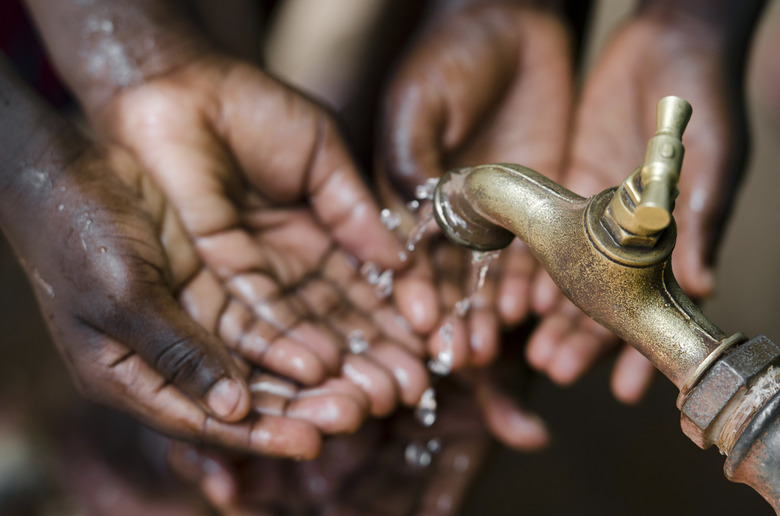Differences Between A Confined Aquifer & An Unconfined Aquifer
Aquifers are bodies of water located underground. They may be enclosed within surrounding rock, which is called a confined aquifer, or exist within a layer of water-saturated gravel or sand, which is called an unconfined aquifer. Both kinds of aquifers are used for irrigation, industrial applications and consumption. Potable water is becoming a prized resource, as many aquifers around the world are shrinking from overuse as the global population increases. Aquifer replenishment is also dependent on a complex interaction of climate and weather patterns.
Aquifer Formation
Aquifer Formation
Aquifers are created when water seeps through earth and permeable rock until reaching a layer of impermeable rock. Groundwater then saturates the surrounding rock or sand, forming an aquifer. A confined aquifer forms when water collects, by pressure or gravity, between two layers of impermeable rock. Fissures in solid rock also allow water to pool. Unconfined aquifers form at a quicker rate compared to confined aquifers. This is because they are in closer proximity to water sources from rain, streams or rivers. By contrast, confined aquifers are fed by underground tributaries.
Surrounding Rock and Soil
Surrounding Rock and Soil
Unconfined aquifers are typically below major water courses such as rivers. These systems provide a constant source of water that seeps down to form the aquifer. The strata of the aquifer itself can be comprised of porous rock such as limestone, or sand and gravel. Unconfined aquifers then filtrate into confined aquifer systems, which are bounded by layers of finer and more impermeable materials such as clay. Aquifers may pool in fissures of basalt and granite and eventually seal off, creating a confinement zone.
Contamination
Contamination
Unconfined aquifer water has a greater exposure to contamination from external sources, such as rain, streams and rivers. Water that seeps into unconfined aquifers may also originate from urban sources, such as canal and drain runoff. As a result, these aquifers may be exposed to a higher risk of contamination from bacteria and decaying organic material. Confined aquifers that are sealed in impermeable rock are protected from contaminants.
Rate of Replenishment
Rate of Replenishment
The rate of replenishment for an unconfined aquifer depends entirely on its proximity to external water sources, and the length of time it takes for water to recharge it, which in turn is dependent on soil and sand consistency. In the case of confined aquifers, replenishment can take a long time, as its sources of water are underground systems that have to travel long distances. Many confined aquifers deep underground have long since been cut off from replenishment sources; once accessed as a water supply, they will eventually be depleted.
Cite This Article
MLA
Conceicao, Peter De. "Differences Between A Confined Aquifer & An Unconfined Aquifer" sciencing.com, https://www.sciencing.com/differences-confined-aquifer-unconfined-aquifer-8749041/. 13 March 2018.
APA
Conceicao, Peter De. (2018, March 13). Differences Between A Confined Aquifer & An Unconfined Aquifer. sciencing.com. Retrieved from https://www.sciencing.com/differences-confined-aquifer-unconfined-aquifer-8749041/
Chicago
Conceicao, Peter De. Differences Between A Confined Aquifer & An Unconfined Aquifer last modified March 24, 2022. https://www.sciencing.com/differences-confined-aquifer-unconfined-aquifer-8749041/
